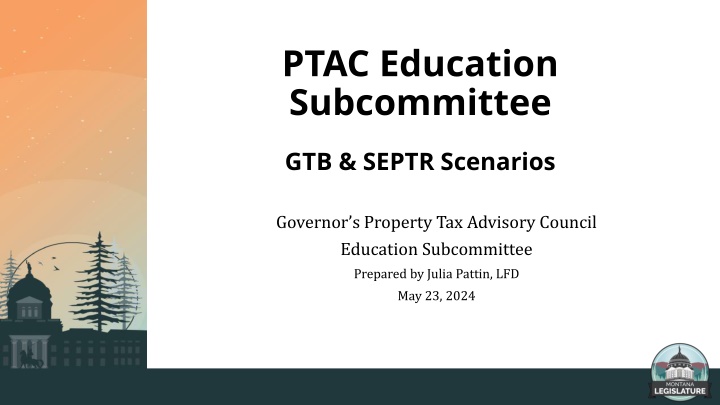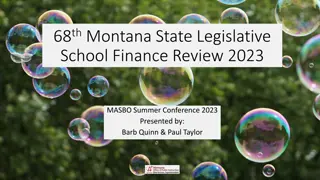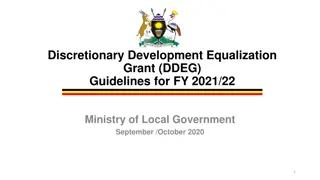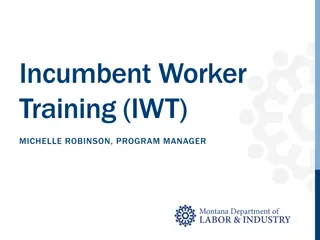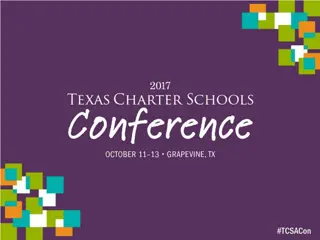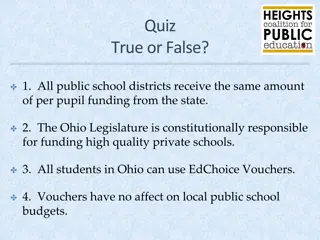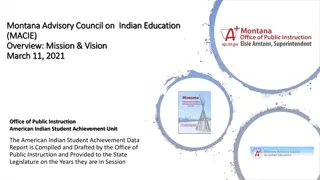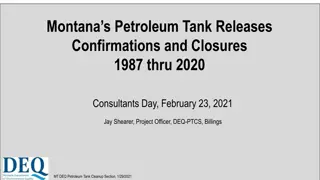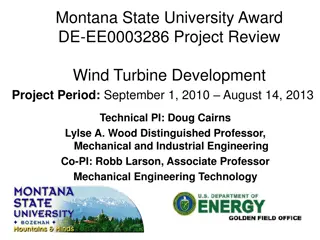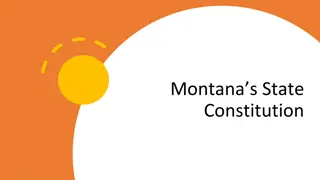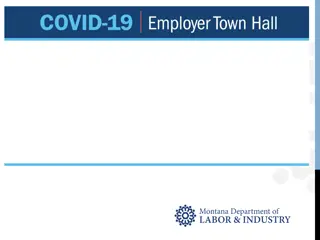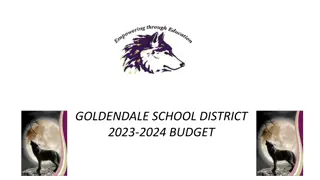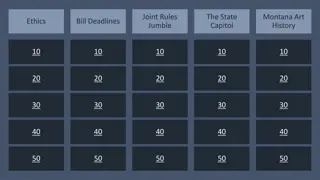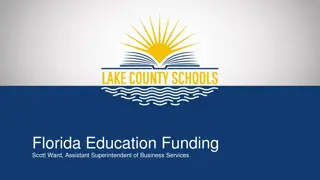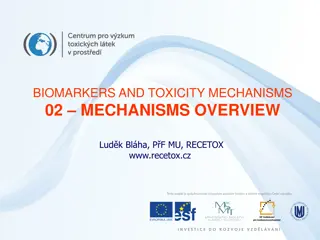Montana School Funding Equalization Mechanisms Overview
Montana's Property Tax Advisory Council's Education Subcommittee explains the Guaranteed Tax Base (GTB) and School Equalization and Property Tax Reduction (SEPTR) mechanisms that aim to equalize revenue-generating capacity among school districts. GTB aid subsidies are provided to districts with less property tax wealth, while SEPTR gradually shifts state to local revenue ratios to 70:30, reducing local property taxes. These initiatives help balance funding between state and local sources for K-12 education in Montana.
Download Presentation

Please find below an Image/Link to download the presentation.
The content on the website is provided AS IS for your information and personal use only. It may not be sold, licensed, or shared on other websites without obtaining consent from the author.If you encounter any issues during the download, it is possible that the publisher has removed the file from their server.
You are allowed to download the files provided on this website for personal or commercial use, subject to the condition that they are used lawfully. All files are the property of their respective owners.
The content on the website is provided AS IS for your information and personal use only. It may not be sold, licensed, or shared on other websites without obtaining consent from the author.
E N D
Presentation Transcript
PTAC Education Subcommittee GTB & SEPTR Scenarios Governor s Property Tax Advisory Council Education Subcommittee Prepared by Julia Pattin, LFD May 23, 2024
GTB aid equalizes districts revenue-generating capacity by providing a state GTB aid subsidy for districts with less property tax wealth to bring their revenue-generating capacity (based on the district GTB ratio) to a guaranteed amount 50 Changing the GTB ratio changes the guaranteed amount, which makes more/fewer districts eligible for GTB aid and changes the amount of GTB aid received by eligible districts. 40 30 GTB Ratio 20 Guaranteed Tax Base (GTB) Aid 10 0 A B C D E F G H I J Example School Districts A district s revenue-generating capacity is measured as a ratio of the district s property wealth (taxable value) to its local funding needs and costs (sometimes ANB, but in our district general fund formula, the GTB area). 2
GTB provides support for low tax value and/or high student areas. When combined with the school funding formula, this promotes base level equal opportunities for students across Montana. For example, Ennis K-12 and Superior K-12 school districts have relatively comparable enrollment (ANB), and Superior K-12 receives GTB aid while Ennis K-12 does not: School District Ennis K-12 Superior K-12 ANB Taxable Value $191.4M $5.2M GTB BASE Levy Revenue $1,217,878 $249,824 Mill Value Number of Mills 425 351 $0 $191,381 $5,196 6.36 48.08 $791,827 This is due to the difference in tax bases for the districts. Guaranteed Tax Base (GTB) Aid The number of mills it would take to raise $1.0 million for those two districts WITHOUT GTB are calculated below: School District ANB Taxable Value $191.4M $5.2M GTB Levy Revenue $1,000,000 $1,000,000 Mill Value Number of Mills Ennis K-12 Superior K-12 425 351 $0 $0 $191,381 $5,196 5.23 192.46 It would take Superior K-12 192.46 mills to collect $1.0 million, while Ennis K-12 would need only 5.23 mills to do the same. GTB aid helps equalizes the tax burden for education between different areas.
This portion of the law is effective beginning in FY 2025 ( hard coded increase) and FY 2026 ( dialing mechanism) New SEPTR Account (School Equalization and Property Tax Reduction) Each equalization mechanism is dialed up until the ratio of state to local revenue reaches approximately 70:30 (debt service 20:80) then the revenue increase from the 95 mills flows to next mechanism Receives revenue from the 95 mill statewide equalization levies, with 55% of increased revenue over prior year triggering a reduction in local property taxes through equalization mechanisms 55% of Increase countywide school retirement GTB to lower county property taxes Utilizing a portion of the 95 mill increase means that the remaining increase can be used to fund annual increases in the existing K-12 formula. This maintains a balance between property tax and other taxes in the state general fund (largely income) in funding K-12. 2nd Source of State School Funding; any remaining state obligation comes from the general fund This portion of the law is already in effect (as of July 1, 2023) Increase state major maintenance aid to lower school district property taxes The SEPTR account also helps maintain a balance between state and local funding for K-12. Historically, during Montana budget shortfalls K-12 costs have shifted onto local taxpayers. Increase debt service assistance to lower school district property taxes If there is a reduction in revenue (not just mills) brought in by the 95 mills from the prior year, BASE GTB and countywide retirement GTB are dialed down by the full amount of the decrease, shifting costs back onto local taxpayers When K-12 leans harder on local property taxes, the more the Legislature s constitutional duty to distribute [K-12 funding] in an equitable manner can be questioned.
State Funding for the District General Fund and Countywide School Retirement Fund All revenue generated by the state-wide 95-mill levy is returned to school districts per law: $1,000,000,000 $900,000,000 From 20-9-331 on the 33 mills: The revenue collected from this levy must be apportioned to the support of the elementary BASE funding programs of the school districts in the county and to the school equalization and property tax reduction account established in 20-9- 336 The 95-mill levy does not meet the state's entire obligation for BASE school funding. (primarily income tax) $800,000,000 State general fund $700,000,000 $600,000,000 From 20-9-333 on the 22 mills: The revenue collected from this levy must be apportioned to the support of the BASE funding programs of high school districts in the county and to the school equalization and property tax reduction account established in 20-9-336 $500,000,000 (primarily income tax) State general fund $400,000,000 From 20-9-360 on the 40 mills: Proceeds of the levy must be remitted to the department of revenue, as provided in 15-1-504, and must be deposited to the credit of the school equalization and property tax reduction account established in 20-9-336 for state equalization aid to the public schools of Montana. $300,000,000 Guarantee Account 95 mills $200,000,000 $100,000,000 The 95-mill revenue Is appropriated to schools in HB 2 (the main state funding bill): Guarantee account $0 District GF District GF District GF Retire Fund Retire Fund Retire Fund FY 2025* FY 2023 FY 2024*
FY 2024 District General Fund Total state funding for schools: $955M Portion funded by the 95 mills: $445M Remainder state general fund (primarily income tax), guarantee account, & other: $530M FY 2023 District General Fund Total state funding for schools: $935M Portion funded by the 95 mills: $350M Remainder state general fund (primarily income tax) & guarantee account, & other: $585M $1,200,000,000 This chart only shows BASE (non-voted) levies for the District General Fund. There are additional voted local levies in the District General Fund that are not shown here FY 2025 District General Fund Total state funding for schools: $1,013M Portion funded by the 95 mills: $458M Remainder state general fund (primarily income tax), guarantee account, & other: $580M $1,000,000,000 $800,000,000 Funding sources for the district general fund and retirement fund State Funding for Schools State Funding for Schools State Funding for Schools $600,000,000 $400,000,000 State General Fund (primarily income tax) $200,000,000 State Levy (95 mills) $0 Guarantee Account District GF Retire Fund District GF Retire Fund District GF Retire Fund *FY 2024-2025 are estimated FY 2025* FY 2023 FY 2024*
$1,200,000,000 State General Fund (primarily income tax) $1,000,000,000 State Levy (95 mills) In FY 2025, the district general fund GTB formula will also self-correct for a lag in taxable values and will decrease local BASE levies (non- voted) in the district general fund by ~$20M In FY 2024, the 95 mills brought in $75M more than in FY 2023, decreasing the amount of state general fund (primarily income tax) needed for school funding $800,000,000 Guarantee Account How the SEPTR dial will affect funding for FY 2024 and FY 2025 $600,000,000 $400,000,000 $200,000,000 In FY 2025, the hardcoded retirement GTB ratio increase based on the increased revenue from the 95 mills will increase the state general fund contribution to school retirement and decreasenon-votedlocal property tax levies for retirement by ~$33M $0 District GF Retire Fund District GF Retire Fund District GF Retire Fund *FY 2024-2025 are estimated FY 2025* FY 2023 FY 2024*
$1,200,000,000 State General Fund (primarily income tax) $1,000,000,000 State Levy (95 mills) $800,000,000 Guarantee Account How the SEPTR dial will affect funding for FY 2024 and FY 2025 $600,000,000 $400,000,000 As the 95 mills bring in more revenue, the SEPTR dial calculation (based on that increase in the 95 mills) bumps $200,000,000 $33M of the offset state general fund contribution for FY 2025 and then 55% of the offset state general fund contribution from FY 2026 onward $0 District GF District GF District GF Retire Fund Retire Fund Retire Fund overflows from the district general fund into the county retirement fund, ensuring that a portion of increases in revenue from the 95 mills go toward reducing local property taxes *FY 2024-2025 are estimated FY 2023 FY 2024* FY 2025*
Legislative action needed to change the SEPTR dial $1,200,000,000 Tax impact scenarios: BASE GTB ratio & SEPTR dial Tax Changes for FY 2026 55% State General Fund (primarily income tax) Retirement Levies $1,000,000,000 75% 100% $6M $12M - $800,000,000 BASE GTB ratio: 262% (current law) ($6M) ($12M) - $600,000,000 SEPTR dial: 55% (current law) 75% 100% $400,000,000 State General Fund (primarily income tax) $200,000,000 State Levy (95 mills) $0 District GF District GF District GF District GF District GF Retire Fund Retire Fund Retire Fund Retire Fund Retire Fund Guarantee Account *Estimates FY 2026* 55% FY 2026* 75% FY 2026* 100% FY 2024* FY 2025*
Legislative action needed to change the SEPTR dial $1,200,000,000 Tax impact scenarios: BASE GTB ratio & SEPTR dial $1,000,000,000 Tax Changes for FY 2026 262% State General Fund (primarily income tax) 275% 2,650% $7M $130M $800,000,000 - BASE GTB ratio: 262% (current law) 275% 2,650% BASE Levies ($7M) ($130M) - $600,000,000 BASE General Fund & Retirement Levies SEPTR dial: 55% (current law) $400,000,000 State General Fund (primarily income tax) $200,000,000 State Levy (95 mills) $0 District GF District GF District GF District GF District GF Retire Fund Retire Fund Retire Fund Retire Fund Retire Fund Guarantee Account *Estimates FY 2026* 275% FY 2026* 2650% FY 2024* FY 2026* 262% FY 2025*
Total reduction in BASE and retirement levies for FY 2026 under various SEPTR and GTB scenarios SEPTR dial: 55% (current law) SEPTR dial: 75% SEPTR dial: 100% BASE GTB ratio: 262% (current law) $0 ($6M) ($12M) BASE GTB ratio: 275% ($7M) ($13M) ($19M) BASE GTB ratio: 2,650% ($130M) ($136M) ($142M)
Legislative action needed to change the 95 mills to 79 mills How would the SEPTR mechanism work if the 95 mills are reduced in FY 2026? $1,400,000,000 If the state levy were to float (without mill banking), the load on the state general fund (primarily income tax) and local levies for the district general fund BASE budget and retirement would increase $1,200,000,000 $1,000,000,000 Even with the SEPTR dial at 100%, reducing the 95 mills to 79 would reduce the amount of revenue and dampen the effects of the SEPTR dial calculation. $800,000,000 State levy: 79 mills (floating) SEPTR dial: 100% $600,000,000 The $33M increase in state funding for the Retirement Fund is hard-coded for FY 2025, but for FY 2026 and beyond, the state retirement contribution would remain relatively flat. $400,000,000 Changes from FY 2025 State Levy Local Levies State GF FY 2026 ($54M) $47M $42M BASE General Fund & Retirement Levies State General Fund (primarily income tax) State Levy (95 mills) $200,000,000 FY 2027 ($50M) $78M $45M $0 FY 2028 ($45M) $104M $54M District GF District GF District GF District GF District GF District GF Retire Fund Retire Fund Retire Fund Retire Fund Retire Fund Retire Fund FY 2029 ($40M) $137M $57M Guarantee Account FY 2025* FY 2024* FY 2027* FY 2028* FY 2029* FY 2026* *Estimates
